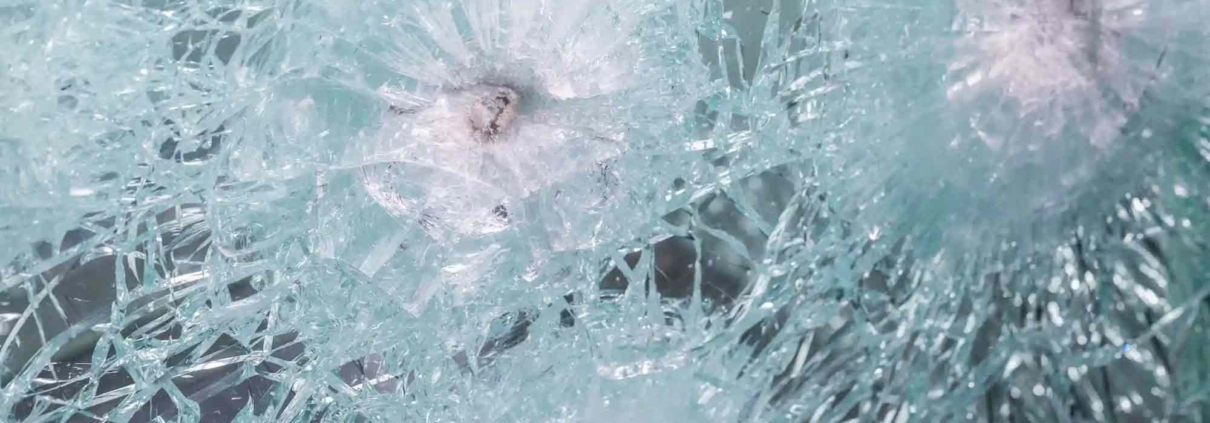Types of Bullet Resistant Glass
When people think of security upgrades, they often picture cameras, locks or alarm systems. But one of the most critical and overlooked components of any secure building or vehicle is the glass that protects it.
Bullet resistant glass is engineered to slow down or stop bullets, offering protection in places where standard glass would shatter instantly. While traditional glass is brittle and fragile under impact. Designed to absorb energy and hold together on impact, bullet resistant glass prevents shattering and penetration.
The term “bullet resistant” is more accurate than “bulletproof” because no material is completely impenetrable under all conditions. Instead, this specialized glass is rated to resist specific types of ballistic threats. It’s a vital element in government buildings, military facilities, banks, schools and high-security commercial properties. In many of these environments, the glass isn’t just a barrier—it’s a lifesaving layer of protection.
If you’re comparing bulletproof vs bullet resistant, the key difference lies in expectations. “Bulletproof” implies infallibility, which doesn’t exist. “Bullet resistant” reflects a tested, rated capability to withstand certain ballistic threats.
Types of Bullet Resistant Glass and Their Characteristics
There are several types of bullet resistant glass, each designed with different use cases, impact resistance and aesthetic preferences in mind. The choice comes down to the level of protection required, weight tolerance, and installation location.
Laminated Bullet Resistant Glass
This is one of the most common and cost-effective forms of bullet resistant glazing. It’s made by sandwiching layers of glass and plastic (typically polyvinyl butyral or PVB) under heat and pressure. When struck, the outer layer may crack, but the interlayer holds the structure together, slowing the bullet and minimizing spall (fragments flying off the rear face).
Pros: Excellent optical clarity, cost-effective, strong resistance to impact.
Cons: Can be heavy, especially at higher protection levels.
Best Use Cases:
- Government buildings: Provides clean sightlines and protection in lobbies, reception desks and perimeter glazing. Often used in UL 752 Level 1–3 applications.
- Banks and financial institutions: Ideal for teller windows and secure counters because it offers bullet resistance with clear communication.
- Schools: Used in entry vestibules and classroom doors to delay active threats and give staff time to initiate lockdown procedures.
- Retail stores (jewelry, cannabis, electronics): Resists smash-and-grab and firearm threats while maintaining visibility.
Why It’s Ideal: Laminated glass is tough, visually clear and available in a range of protection levels. It’s also more resistant to forced entry than regular tempered glass, making it a solid choice for facilities prioritizing both transparency and safety.
Polycarbonate Bullet Resistant Glass
This is a plastic-based monolithic sheet (or sometimes multi-layered) designed to absorb ballistic impact through flexion and dispersion. It doesn’t shatter like glass and can stop bullets by deforming under impact.
Pros: Lightweight, shatter-resistant, good for retrofits where weight matters.
Cons: Scratches more easily, may yellow over time without protective coatings.
Best Use Cases:
- Vehicles: Especially useful in law enforcement or security transport, where weight matters and speed/mobility must be preserved.
- Security booths and kiosks: Lightweight and easy to install in retrofitted environments where glass may not be practical.
- Temporary or modular structures: Good for pop-up security stations, event security or mobile units where glazing must be installed and removed with minimal disruption.
Why It’s Ideal: Polycarbonate is lightweight, flexible and resistant to shattering. It won’t crack like glass, making it a good option for mobile or weight-sensitive applications. However, it’s more prone to scratching and yellowing, so it’s best used in locations where visual aesthetics are less of a concern.
Glass-Clad Polycarbonate (GCP)
This hybrid structure combines the best of both materials. Layers of glass and polycarbonate are laminated together, often with urethane interlayers, creating a balanced product with improved durability and ballistic resistance.
Pros: Higher clarity than polycarbonate alone, strong resistance to bullets and forced entry.
Cons: More expensive than single-material options, complex manufacturing.
Best Use Cases:
- Insulated Ballistic Glass
This system combines bullet resistant glazing with insulating glass units (IGUs) used in energy-efficient windows. It may include a ballistic-rated pane as one layer of the insulated assembly, offering both security and thermal performance.
Pros: Energy efficiency, sound reduction, ballistic protection in one.
Cons: Heavier and more expensive; limited availability in extreme protection levels.
Best Use Cases:
- Schools and universities: Especially in areas with extreme climates, where energy efficiency is just as important as physical security.
- Hospitals and healthcare facilities: Where staff and patient protection is important, but HVAC performance must be maintained.
- Corporate campuses: Useful for LEED-certified or energy-conscious buildings that also require physical security.
- High-end residences: In luxury homes with security concerns, it allows for both comfort and peace of mind.
Why It’s Ideal: Insulated ballistic glass is perfect for buildings that need security without sacrificing energy performance. It helps maintain comfortable interior conditions and reduces noise, while still stopping bullets—ideal for places where people live, work or receive care.
Each type of ballistic glass offers unique advantages depending on your needs. For high-profile government installations, composite solutions are typical, while retail and commercial offices may opt for lighter, laminated systems.
Bullet Resistant Glass Standards and Safety Ratings
Not all bullet resistant products are created equal. Safety and performance are governed by standardized testing and classification systems that ensure consistency across manufacturers.
UL 752 Standards
The UL 752 standard, developed by Underwriters Laboratories, defines performance levels based on caliber, velocity and type of firearm. It includes Levels 1 through 10, where Level 1 resists small-caliber handguns and Level 10 withstands multiple shots from high-powered rifles like the .50 caliber.
Each level reflects real-world threats, such as:
- Level 1: 9mm handgun
- Level 3: .44 Magnum
- Level 8: 7.62mm rifle rounds
- Level 10: .50 caliber threats
The bulletproof glass standards page provides a breakdown of these and other relevant benchmarks.
EN 1063 (European Standards)
In international applications, the EN 1063 standard classifies bullet resistance with a “BR” rating system. These ratings are similar to UL 752 but include additional threat levels like armor-piercing ammunition.
Testing and Assessment
Glass is tested by firing multiple rounds at specified distances and checking for penetration or spall. To meet a rating, the product must prevent complete penetration in all test shots. This ensures the integrity of both the glazing and surrounding frame.
Maintenance and Care of Bullet Resistant Glass
While bullet resistant glass is engineered to be durable, it still requires proper maintenance to retain effectiveness.
Cleaning Guidelines
Use non-abrasive cleaners and soft cloths to prevent scratches, especially on polycarbonate surfaces. Avoid ammonia-based products, which can degrade the interlayers or protective coatings over time.
Inspection and Repairs
Regularly inspect for chips, delamination or discoloration, particularly at the edges and around the frame. Damage should be evaluated by a certified technician immediately, as even small flaws can compromise ballistic integrity.
If a bullet resistant window sustains impact—even if there’s no visible penetration—schedule a professional assessment to determine whether replacement or reinforcement is necessary.
Environmental Considerations
Prolonged UV exposure can yellow or degrade certain materials. Many systems include UV filters or hard coatings, but indoor applications should still be protected from direct sunlight when possible.
Cost and Installation of Bullet Resistant Glass
The cost of bullet resistant glass depends on a few key factors:
- Material Type: Polycarbonate is usually less expensive than glass-clad polycarbonate.
- Level of Protection: Higher UL levels mean thicker, heavier, and more costly panels.
- Size and Customization: Custom shapes, curved glass or oversized panels increase cost.
- Framing Systems: A bullet resistant frame is essential to performance and is priced separately.
Installation Process
Installing resistant glass isn’t as simple as swapping out a pane. It often requires structural modifications, especially in older buildings or vehicles.
Here’s a general overview:
- Site Evaluation: Determine threat level, structural compatibility and glass type.
- System Selection: Choose from certified options that match the need—such as bullet resistant windows.
- Framing Installation: Reinforced frames are mounted and anchored into the building envelope.
- Glass Integration: Glazing is sealed within the frame to ensure ballistic performance.
- Testing and Certification: Some high-security installations require final inspection and documentation.
In new construction, incorporating ballistic glass from the start is more efficient than retrofitting later. For renovations, lightweight options like polycarbonate can ease installation challenges.
Built-In Security For What Matter Most
From commercial storefronts to federal buildings, bullet resistant glazing plays a crucial role in modern security strategies. It’s not just about stopping bullets—it’s about buying time, protecting lives and deterring threats.
Whether you need basic protection from small arms or high-level defense against rifles, there’s a solution that fits. The right bulletproof glass setup depends on understanding the threat level, choosing the appropriate materials and making sure the installation meets certified standards.
Security planning isn’t complete without evaluating vulnerable entry points—especially glass. Incorporating bulletproof windows early in your design or retrofitting existing ones can be the difference between a near-miss and a serious threat.
When lives are on the line, there’s no substitute for tested, rated and professionally installed ballistic glass.


